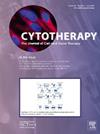Circumventing Pediatric Solid Tumor Microenvironment Resistance by Combinatorial CAR NK and Immunomodulating Therapy
IF 3.7
3区 医学
Q2 BIOTECHNOLOGY & APPLIED MICROBIOLOGY
引用次数: 0
Abstract
Background & Aim
Patients diagnosed with relapsed/refractory (R/R) Neuroblastoma (NB) and Sarcoma (SARC) have a dismal outcome. Lines of evidence have shown the importance of NK cell immunity against NB and SARC. However, NK cell number and function are low in NB and SARC patients, in large part due to the immunosuppressive tumor microenvironment (TME). Our aim is to improve NK therapy against R/R NB and SARC by strategic combinations that simultaneously enhance tumor specific targeting of NK cells via chimeric antigen receptor (CAR), increase NK migration and tumor infiltration by engineering CAR NK cells to express tumor attracting chemokine receptor CXCR2, improve NK cell ADCC by a GD2 antibody dinutuximab, enhance NK cell persistence and the immune synapse between cancer and NK cells via a tri-specific killer engager Cam1615B7H3, and increase expression of NK activating receptor ligands (MICA/B) on tumor cells by a HDAC inhibitor romidepsin.
Methodology
NK cells were expanded using K562-mbIL-21-41BBL feeder cells and IL-2. Expanded NK cells were engineered to co-express ROR1 CAR and CXCR2 using mRNA electroporation. NK cell cytotoxicity was evaluated by luciferase-based cytotoxicity assay. In vitro transwell assays were performed to determine the migratory ability of CAR NK and CAR CXCR2 NK cells. Flow cytometry was utilized to evaluate MICA/B expression on tumor cells treated with or without romidepsin.
Results
We found that compared to mock NK cells, ROR1 CAR NK cells had significantly enhanced cytotoxicity against NB (SKNFI) and SARC (A673 and U2OS) cells at various T:E ratios (p<0.05). While the in vitro cytotoxicity of CAR NK and CAR CXCR2 NK cells was very similar (Fig.1A), co-expression of CXCR2 on CAR NK cells significantly enhanced their migration towards the conditioned media of tumor cells (p<0.05 and p<0.01) (Fig.1B). Both dinutuximab and cam1615B7H3 significantly enhanced in vitro cytotoxicity of CAR CXCR2 NK cells against tumor cells (p<0.05 and p<0.01) (Fig.1C and 1D). MICA/B expression on U2OS but not A673 or SKNFI cells was markedly increased (33% vs 72%) after romidepsin treatment (Fig.1E). We observed significantly enhanced cytotoxicity of CAR NK cells when combined with romidepsin compared to CAR NK cells alone against U2OS cells (p<0.01) (Fig.1F).
Conclusion
Our results demonstrated the in vitro anti-tumor efficacy of ROR1 CAR CXCR2 NK cells in combination with dinutuximab, cam1615B7H3 and/or romidepsin against malignant NB and SARC. Supported by U54 CA232561 and ALSF reach grant.
联合CAR - NK和免疫调节治疗规避儿童实体肿瘤微环境耐药
背景,复发/难治性(R/R)神经母细胞瘤(NB)和肉瘤(SARC)患者的预后令人沮丧。一系列证据表明NK细胞免疫对NB和SARC的重要性。然而,NB和SARC患者的NK细胞数量和功能较低,很大程度上是由于免疫抑制肿瘤微环境(TME)。我们的目标是通过策略组合来改善NK对R/R NB和SARC的治疗,同时通过嵌合抗原受体(CAR)增强NK细胞的肿瘤特异性靶向,通过工程CAR NK细胞表达肿瘤趋化因子受体CXCR2来增加NK迁移和肿瘤浸润,通过GD2抗体dinutuximab改善NK细胞ADCC,通过三特异性杀手接合物Cam1615B7H3增强NK细胞的持续性和癌症与NK细胞之间的免疫突触。并通过HDAC抑制剂罗米地辛增加肿瘤细胞上NK激活受体配体(MICA/B)的表达。方法使用K562-mbIL-21-41BBL喂料细胞和IL-2扩增ynk细胞。扩增NK细胞通过mRNA电穿孔共表达ROR1 CAR和CXCR2。采用荧光素酶细胞毒性试验评价NK细胞的细胞毒性。体外transwell法测定CAR NK细胞和CAR CXCR2 NK细胞的迁移能力。流式细胞术检测罗米地辛处理或不处理肿瘤细胞MICA/B的表达。结果与模拟NK细胞相比,ROR1 CAR NK细胞在不同T:E比下对NB (SKNFI)和SARC (A673和U2OS)细胞的毒性显著增强(p<0.05)。虽然CAR - NK细胞和CAR - CXCR2 NK细胞的体外细胞毒性非常相似(图1a),但CAR - NK细胞上共表达CXCR2显著增强了它们向肿瘤细胞条件培养基的迁移(p<;0.05和p<;0.01)(图1b)。迪努妥昔单抗和cam1615B7H3均显著增强CAR - CXCR2 NK细胞对肿瘤细胞的体外细胞毒性(p<;0.05和p<;0.01)(图1c和1D)。罗米地辛处理后,MICA/B在U2OS细胞上的表达明显增加(33% vs 72%),而在A673细胞和SKNFI细胞上的表达没有明显增加(图1e)。我们观察到,与CAR NK细胞单独使用罗米地辛相比,CAR NK细胞联合使用罗米地辛对U2OS细胞的细胞毒性显著增强(p<0.01)(图1f)。结论ROR1 CAR - CXCR2 NK细胞联合地妥昔单抗、cam1615B7H3和/或罗米地辛对恶性NB和SARC具有体外抗肿瘤作用。由U54 CA232561和ALSF资助。
本文章由计算机程序翻译,如有差异,请以英文原文为准。
求助全文
约1分钟内获得全文
求助全文
来源期刊

Cytotherapy
医学-生物工程与应用微生物
CiteScore
6.30
自引率
4.40%
发文量
683
审稿时长
49 days
期刊介绍:
The journal brings readers the latest developments in the fast moving field of cellular therapy in man. This includes cell therapy for cancer, immune disorders, inherited diseases, tissue repair and regenerative medicine. The journal covers the science, translational development and treatment with variety of cell types including hematopoietic stem cells, immune cells (dendritic cells, NK, cells, T cells, antigen presenting cells) mesenchymal stromal cells, adipose cells, nerve, muscle, vascular and endothelial cells, and induced pluripotential stem cells. We also welcome manuscripts on subcellular derivatives such as exosomes. A specific focus is on translational research that brings cell therapy to the clinic. Cytotherapy publishes original papers, reviews, position papers editorials, commentaries and letters to the editor. We welcome "Protocols in Cytotherapy" bringing standard operating procedure for production specific cell types for clinical use within the reach of the readership.
 求助内容:
求助内容: 应助结果提醒方式:
应助结果提醒方式:


